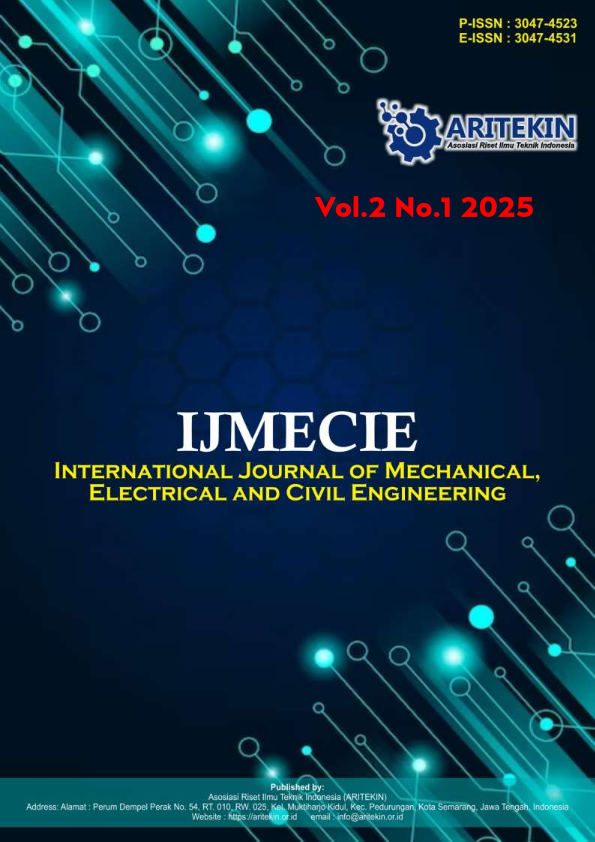Study Of Compressive And Flexural Strength Of Concrete Using Bima Cement For National Road Reconstruction In Kebumen
DOI:
https://doi.org/10.61132/ijmecie.v1i1.145Keywords:
Bima cement, concrete, compressive strength, flexural strength, KebumenAbstract
Concrete is an important aspect of building construction, one of which is road construction. Concrete is used for road construction because it has the advantages of high compressive strength, easy maintenance, ease of formation, and easy to obtain components. Road construction using concrete is applied to the reconstruction of the Kebumen South Ring Road, where the Kebumen South Ring Road is a 9.07 km long national road. National roads are arterial and collector roads in the primary road network system that connect provincial capitals, national strategic roads, and toll roads. Therefore, construction on national roads requires strong and good materials on the Kebumen South Ring Road to optimize road use. In this study, the concrete is composed of Bima cement as Portland cement, coarse aggregate from Kebumen, fine aggregate from the Progo River, and water from drilled wells. The admixture was obtained from a Conmix HK 2. Subsequently, all ingredients were mixed using a mixer truck. The concrete mixture was molded into cylinders and blocks. In this study, the average results of the 5-day concrete compressive strength test were obtainedwhich is 373.42 kg/cm2 and 28-day-old concrete is 442.32 kg/cm2. The average result of the 5-day concrete flexural test is50.65 kg/cm2 and that of 28-day-old concrete was 60.73 kg/cm2. The results are in accordance with the general specifications of the Bina Marga, namely, 45 kg.
References
Bina Marga. (2020). General specifications 2018. Ministry of Public Works and Public Housing.
Nasution, M. A., Wilda, K., & Sitanggang, E. S. Y. (2021). Review of compressive and flexural strength of concrete mixture using corn cob ash as partial substitute for fine aggregate. National Conference on Social and Engineering of Medan State Polytechnic 2021.
Pane, F. P., Tanudjaja, H., & Windah, R. S. (2015). Flexural tensile strength testing of concrete with variation of concrete compressive strength. Journal of Civil Statics, 3(5), 313–321. https://doi.org/ISSN:2337-6732
Rahamudin, R. H., Manalip, H., & Mondoringin, M. (2016). Splitting tensile strength and flexural tensile strength testing of lightweight concrete with coarse aggregate (pumice) and rice husk ash as partial substitution of cement. Journal of Civil Statics, 4(3), 225–231. https://doi.org/ISSN:2337-6732
Rahmat, Hendriyani, I., & Pratama, R. D. (2017). Study of concrete flexural strength on rigid pavement of Balikpapan-Samarinda toll road. Civil Engineering Scientific Media, 6(1), 50–60.
Subagyo, S. (2023). Quality of asphalt concrete on the Blondo-Mendhut road section. Mandalika Light Journal, 4(1), 247–255. https://doi.org/10.36312/jcm.v4i1.1330
Sumardi, Z. G., Al Zakina, B. L., & Zainnudin. (2023). Study of compressive strength and flexural strength of normal concrete with nylon fiber additives. TEKSLING: Journal of Civil and Environmental Engineering, 2(1).
Tjokrodimuljo, K. (2007). Concrete technology. Publishing Bureau of Civil Engineering Department, Faculty of Engineering, UGM: Yogyakarta.
Tjokrodimulyo, K. (1996). Concrete technology. NAFIRI: Yogyakarta.
Uu Saepudin, U., Hartati, G., & Bakri, S. N. (2022). Analysis of compressive strength and flexural strength of polymeric fiber concrete as rigid pavement material. Jurnal Media Teknologi, 9(1).
Downloads
Published
How to Cite
Issue
Section
License
Copyright (c) 2025 International Journal of Mechanical, Electrical and Civil Engineering

This work is licensed under a Creative Commons Attribution-ShareAlike 4.0 International License.





